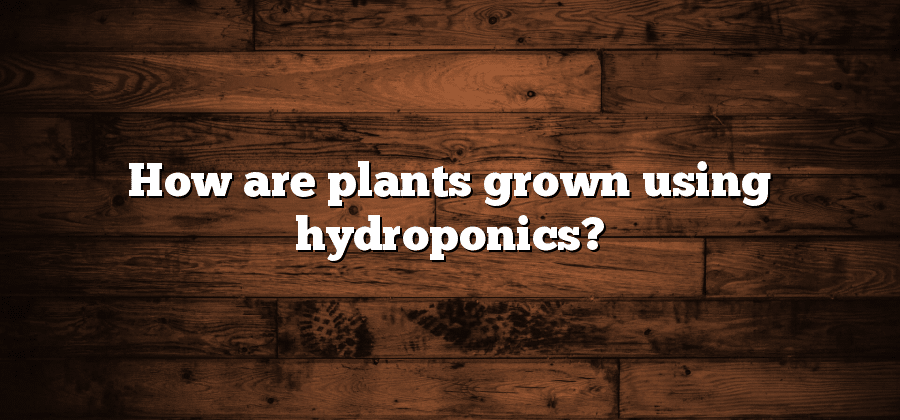Advantages of Hydroponic Plant Cultivation
Hydroponic plant cultivation offers numerous advantages over traditional soil-based farming methods. One of the key benefits is the ability to control and optimize the growing environment. In a hydroponic system, growers have the power to manipulate factors such as nutrient levels, pH, and light intensity to create the ideal conditions for plant growth. This level of control allows for increased productivity and faster growth rates, resulting in higher yields. Additionally, hydroponic systems use a fraction of the water compared to traditional farming methods, making them more efficient and sustainable. By delivering water directly to the plant roots, hydroponics eliminates water wastage through evaporation and run-off. This is particularly important in regions with limited water resources, as it reduces the strain on fresh water supplies.
In addition to water conservation, hydroponic plant cultivation also offers the advantage of better nutrient absorption. In soil-based systems, plants need to expend energy to search for nutrients in the soil. In contrast, hydroponics provides a nutrient-rich solution directly to the plant roots, allowing for more efficient and targeted nutrient uptake. The ability to deliver precise amounts of nutrients ensures that plants have all the essential elements they need for optimal growth. Furthermore, hydroponic systems eliminate the risk of nutrient imbalances or deficiencies that can occur in traditional farming, where nutrient availability can be inconsistent. This results in healthier plants with enhanced growth, vitality, and overall crop quality.
Types of Hydroponic Systems
Hydroponic systems offer a wide range of options for cultivating plants without soil. One common type is the Nutrient Film Technique (NFT) system. In an NFT system, a thin film of nutrient-rich water flows continuously over the roots of the plants. This allows for efficient nutrient uptake while maintaining oxygen levels for root respiration. NFT systems are often used for leafy greens and herbs and are well-suited for commercial-scale operations due to their high productivity and water efficiency.
Another popular hydroponic system is the Deep Water Culture (DWC) system. In a DWC system, plant roots are submerged in a nutrient solution that is constantly aerated using air stones or diffusers. This provides a high level of oxygen to the roots, promoting fast growth and healthy development. DWC systems are relatively easy to set up and maintain, making them suitable for beginners and hobbyists. They are commonly used for growing larger plants such as tomatoes and cucumbers. However, it is important to ensure that the roots do not become waterlogged, as this can lead to root rot and hinder plant growth.
Selection of Plant Varieties for Hydroponics
In hydroponic plant cultivation, the selection of plant varieties is crucial for achieving optimal growth and yield. Unlike traditional soil-based gardening, hydroponic systems provide a controlled environment where plants solely rely on nutrient-rich water solutions for their growth. This allows for the cultivation of a wide range of plant varieties, from leafy greens to flowering plants and even fruiting crops. However, not all plant varieties are equally suited for hydroponics, and careful consideration must be given to selecting the right plants that will thrive in this unique growing environment.
When choosing plant varieties for hydroponics, several factors need to be taken into account. One of the most important considerations is the plant’s ability to adapt to the absence of soil and its capacity to readily uptake nutrients from the water solution. Some plants, such as lettuce, spinach, and herbs like basil and mint, are well-suited for hydroponics due to their shallow root systems and high nutrient uptake efficiency. On the other hand, plants with deep or extensive root systems may not fare as well in hydroponic systems and may require additional support or specialized techniques to ensure proper growth. Additionally, plants with heavy fruit or vegetable yields, such as tomatoes or cucumbers, may have specific requirements in terms of space, support structures, and nutrient delivery systems to accommodate their growth.
Preparation of Hydroponic Growing Medium
Hydroponic plant cultivation offers several advantages over traditional soil-based methods. One of the key components of a successful hydroponic system is the growing medium. Unlike conventional soil that provides nutrients to plants, hydroponic systems require a medium that provides support and stability, while allowing for the delivery of nutrients directly to the plant’s roots.
Choosing the right growing medium for your hydroponic system is crucial. There are various options available, including rockwool, perlite, vermiculite, coco coir, and clay pellets. Each medium has its own set of characteristics and benefits. For example, rockwool is known for its excellent water retention and aeration properties, making it ideal for seed germination. On the other hand, clay pellets are lightweight and provide excellent drainage, preventing waterlogged roots.






